COLESTON 6
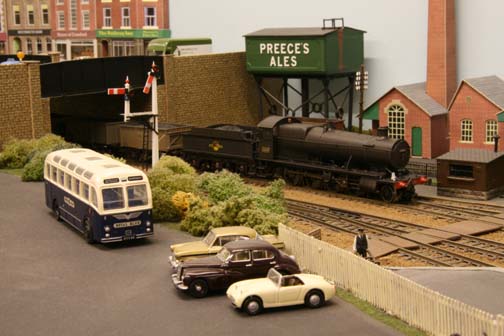 Churchward heavy freight 2-8-0 no.2805
trundles under the Oxford Road bridge, pass the brewery on a coal train.
In 1960, this loco was based at Newton Abbott, and was the oldest surviving
28xx still in service. It still sported inside steam pipes and square drop-frame
ahead of the cylinders. In real life, this loco could sometimes be seen
with a larger tender, but I chose to model it with the normal Chuchward
3500 gallon one. This model is one of the latest Hornby locos. Unfortunately,
when I did this, Hornby didn't make a square-framed loco in BR livery, so
I had to repaint and weather the GWR version, which came with a 'shirtbutton'
totem.
Churchward heavy freight 2-8-0 no.2805
trundles under the Oxford Road bridge, pass the brewery on a coal train.
In 1960, this loco was based at Newton Abbott, and was the oldest surviving
28xx still in service. It still sported inside steam pipes and square drop-frame
ahead of the cylinders. In real life, this loco could sometimes be seen
with a larger tender, but I chose to model it with the normal Chuchward
3500 gallon one. This model is one of the latest Hornby locos. Unfortunately,
when I did this, Hornby didn't make a square-framed loco in BR livery, so
I had to repaint and weather the GWR version, which came with a 'shirtbutton'
totem.
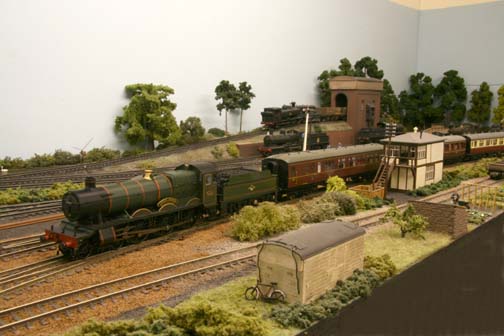 The prototype for the 'Hall' class, no.4900
"Saint Martin", eases past Coleston signal box with a semi-fast
passenger train. Originally no.2925, and built in 1907, this loco was chosen
to be re-built in 1924, with 6 foot diameter driving wheels, in an attempt
to make a mixed-traffic engine from the express passenger 'Saint' type.
Fitted also with a Collett side-window cab, the experiment was a great success,
and the 'Hall' class resulted. She was re-numbered 4900, but kept her original
name. During the 1950s, this loco occasionally ran with a Churchward 3500
gallon tender (instead of the normal,'Hall' 4000 gallon type), and this
is how I have modelled it.
The prototype for the 'Hall' class, no.4900
"Saint Martin", eases past Coleston signal box with a semi-fast
passenger train. Originally no.2925, and built in 1907, this loco was chosen
to be re-built in 1924, with 6 foot diameter driving wheels, in an attempt
to make a mixed-traffic engine from the express passenger 'Saint' type.
Fitted also with a Collett side-window cab, the experiment was a great success,
and the 'Hall' class resulted. She was re-numbered 4900, but kept her original
name. During the 1950s, this loco occasionally ran with a Churchward 3500
gallon tender (instead of the normal,'Hall' 4000 gallon type), and this
is how I have modelled it.
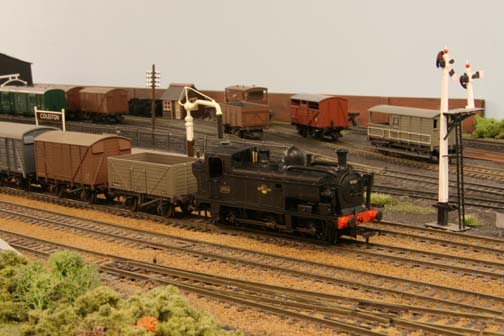 An immaculate Old Oak condensing pannier
tank (presumably on a running-in turn) no.9704 trundles through the station
with a pick-up goods.
An immaculate Old Oak condensing pannier
tank (presumably on a running-in turn) no.9704 trundles through the station
with a pick-up goods.
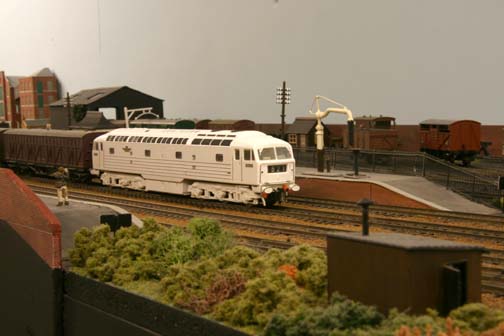 A sign of the times! Prototype diesel "Lion",
thunders through Coleston on a parcels train. When first built, this loco
ran test trains on the Western Region, and London to Bristol parcels workings
were a common duty.
A sign of the times! Prototype diesel "Lion",
thunders through Coleston on a parcels train. When first built, this loco
ran test trains on the Western Region, and London to Bristol parcels workings
were a common duty.
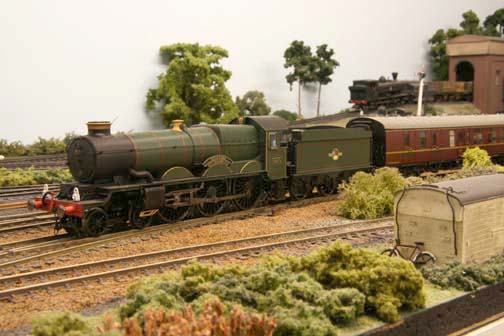 'Castle' class no.5071 "Spitfire"
approaches Coleston on a 'down' express passenger working.
'Castle' class no.5071 "Spitfire"
approaches Coleston on a 'down' express passenger working.
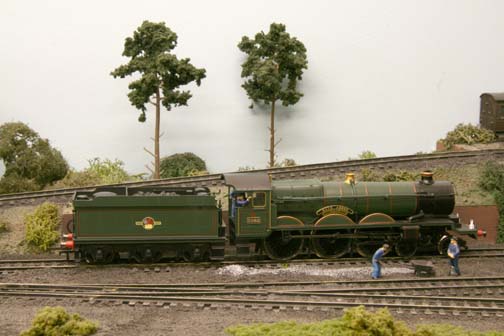 Another one of my 'Castles' - this is one
of the 'Star' rebuilds, no.5083 "Bath Abbey", which has just come
off a through passenger to the north via Oxford (the train being taken over
by an Eastern Region loco). Those two chaps are still trying to clear the
ash pile.
Back to page 5
Back to home page
Go to page 7
Another one of my 'Castles' - this is one
of the 'Star' rebuilds, no.5083 "Bath Abbey", which has just come
off a through passenger to the north via Oxford (the train being taken over
by an Eastern Region loco). Those two chaps are still trying to clear the
ash pile.
Back to page 5
Back to home page
Go to page 7






